
Imaginative Realism: How to Paint What Doesn't Exist by James Gurney
224 Pages - Paperback
Review of Imaginitive Realism by James Gurney
So this book has been on my wishlist for a while and I recently discovered bookdepository which is significantly cheaper for me where I live so I decided to try it out.
Book Depository
First of all you might want to know that the "free" part of the Book depository shipping is actually included in the price and differs depending on where you buy it from. I only realized this because I had someone in the US buy it for me and they told me they actually paid even less than the price I was seeing (which was still ~10 dollars less than amazon). They had no problem putting in my address here in Argentina though. Apparently it's just where the site is seeing you coming from so you could probably use a secure VPN to get around this, but I have no idea how legal that might be or if that breaks their terms of use or something.
They said 15 days max to arrive, but there are crazy import restrictions in my country, so it probably got delayed by customs. It took nearly a month and a half to arrive since they shipped it out. If you're in Argentina I still had to go pick it up and pay $50 pesos, so door-to-door is still not working properly. At least they did not open the package or anything.
Packaging
It was pretty nicely packed in the box you see in the video. In fact I've been struggling without how I'm going to ship paintings if I make them on stretched canvas and I'm going to copy their idea in part because it doesn't require me to buy a box. It's basically made out of one long strip of cardboard cut like the diagram below.
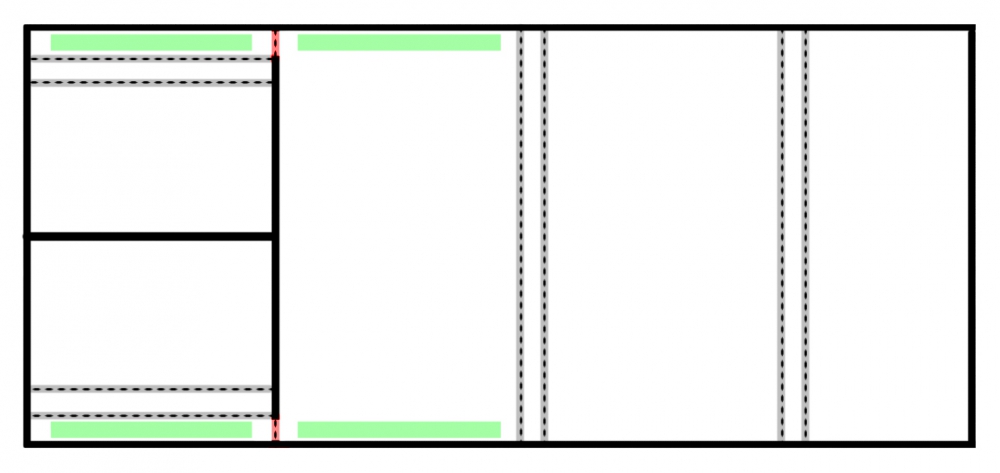
The black lines are cuts. The dotted sections are folds. Then the green parts are where it's glued together. The red is just there to highlight that that part is a fold and NOT a cut.
The box edges itself where a bit damaged, but it's way longer than the book and this protected the book quite well. It has a few marks, nothing noticeable. A corner had started to become de-laminated, but I put some acrylic medium (because it won't yellow) in-between and left it pressed beneath my printer until it dried, and now you can hardly tell. For such a nice book I would have preferred to buy a hardcover version but it's only available as a paperback.
And I absolutely loved this book, and I think all artists will find something helpful in it, but I think if you're like me and you already know how to draw from observation but are struggling to draw more from your imagination, you'll will find this the most useful.
Book Review
What does it cover? / Who is it for?
I think it's important to note first what this book does and doesn't cover. I would personally like to reach the point some day where I can draw from imagination mostly without reference. That I think requires two main things. Being able to draw through construction and amassing a large visual library.
I made a little oversimplified diagram for the video. Obviously people don't follow this perfectly, even me and maybe I'm missing stuff because I'm obviously still somewhere between the first two blocks, but you get the point.
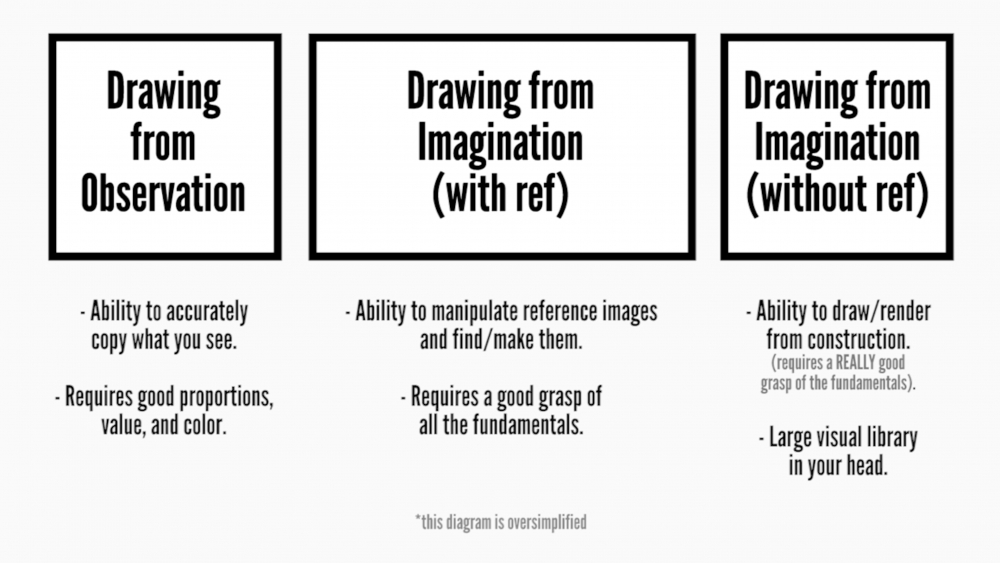
This book doesn't cover those two thing under the third block that I mentioned. Instead it's more about helping to bridge the gap between the first and third blocks in other ways and how you can create works from your imagination with the aid of reference and other techniques. It's not a step by step how to book (though he does show you his steps and process a lot). Instead it's best to think of it like an encyclopedia of illustration techniques.
Structure
The book is divided into sections by these really nice full page paintings on a black background so they're relatively easy to find. Still for the most part it's more like an encyclopedia. Each sub-section listed in the table of contents is a two page spread. Then at the end there's a glossary, a list of recommended reading, a list of Gurney's work and an index.

Content
If you follow Gurney's blog the book came to be in part from the subjects and questions on his blog. So it feels like a very natural extension of it. There are a lot of maquettes, models, and dinosaurs. And inversely sometimes you can look stuff up from the book in his blog for more details, especially his tools and supplies.
For example I had no idea what he meant by a waxer.
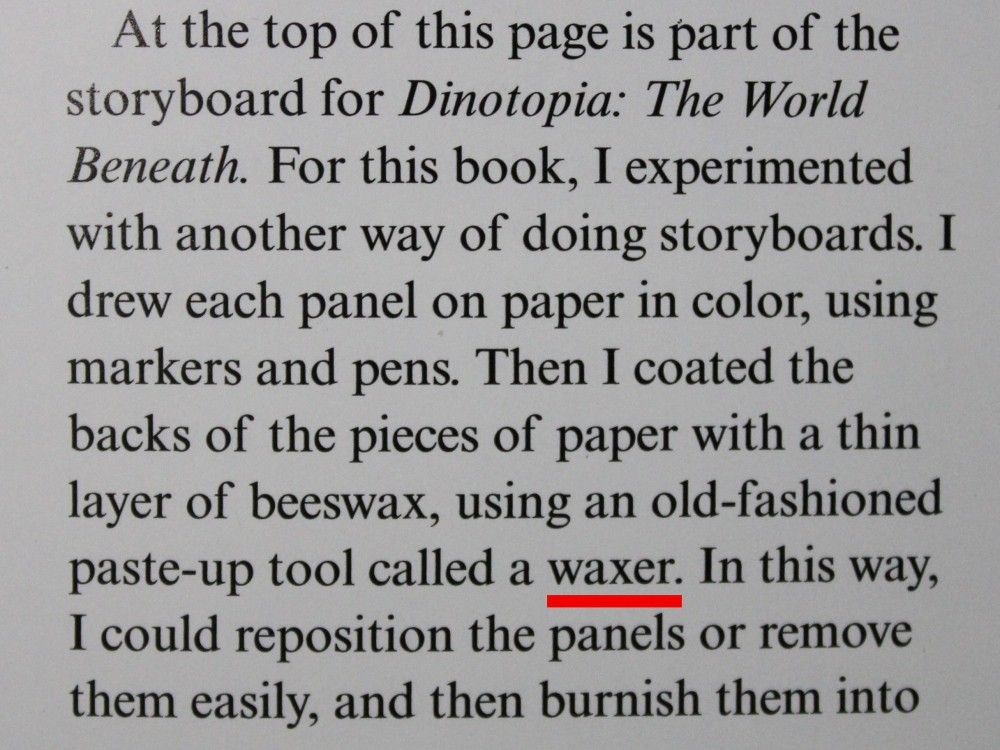
I went to google it (it was not in the glossary), nothing really came up until I put "waxer paste up tool" and one of the results was his blog. So it's best to search his site for anything you don't understand or might want more details on. In google you can do the following: "searchterm site:http://gurneyjourney.blogspot.com" without quotes.
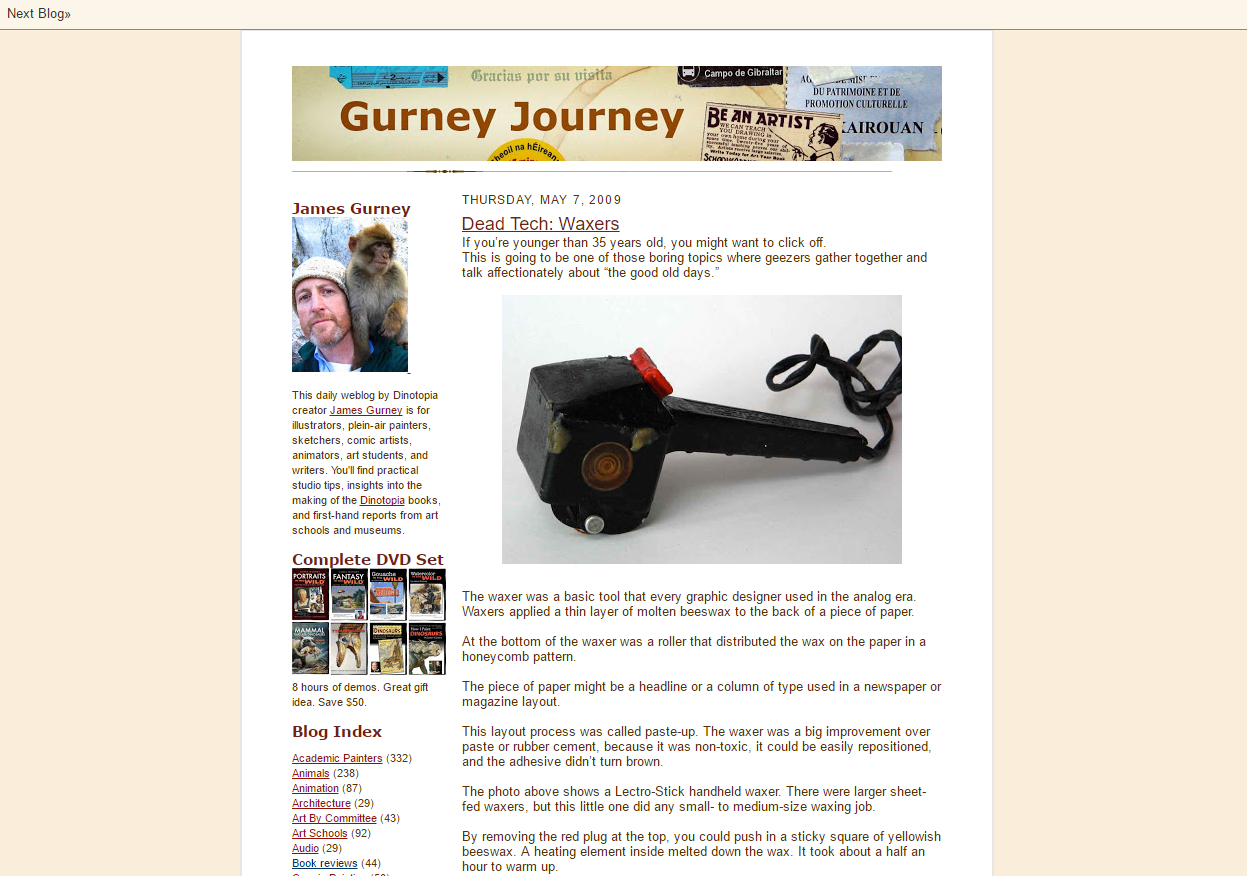
Now I'm the highlighting note taking type and although you can't see what notes I took on the book itself, I don't like to mark my books. The way I take notes is I take a photo then OCR it if necessary (more on that at the end). And in this book I found a lot of interesting stuff. I highlighted over 100 things.
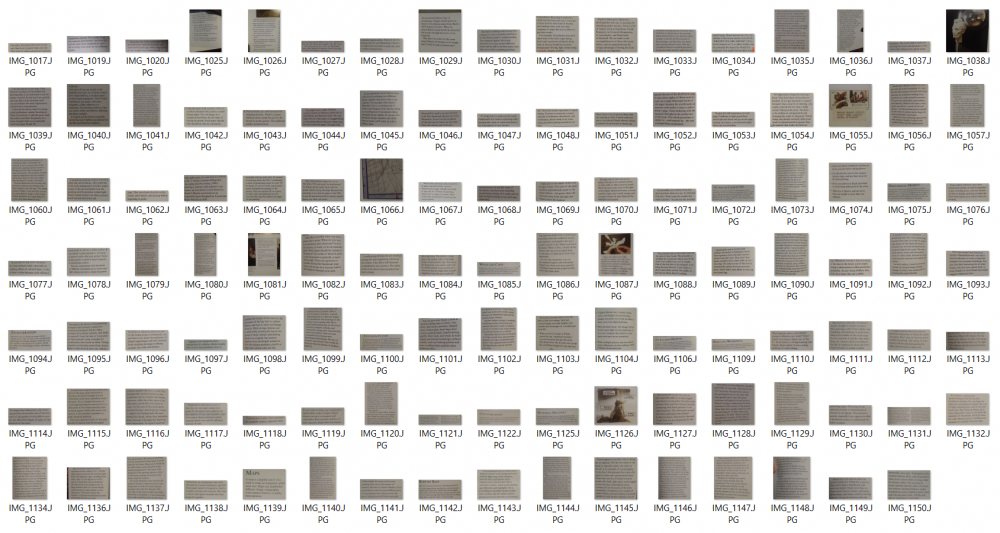
I also really liked that he did a lot of research into other artist's methods, so I discovered a lot of artists I'd never heard of that I'll be looking into.

I'll put the full list under the read more if you're curious. There's also probably even more in the recommended reading section (I've not combed through it yet) which you can read in the amazon preview.
And he also shows you his process for different pieces and how he used a certain technique in a painting, so that was extremely useful and I made quite a large list of things to try. It's a bit unintelligible though without the book as context. You'll probably be seeing me try them if you follow me on twitter, instagram, or facebook.
Overall it was exactly what I needed. There were obviously some techniques I already knew or discovered on my own in some way, but he has a great way of explaining that made me see even techniques I already knew in new way. The following are a few of my favorite parts and it was really hard to narrow it down to these.
Storyboards

In this section he goes into detail on how he used storyboarding to plan his Dinotopia book. What I found interesting is that he used the storyboard in part to help plan the plot and the actual final text was the last thing he wrote. I've been struggling with finishing a book I'm writing for a while now, so I thought it couldn't hurt to try this approach. My book is just a regular novel, no illustrations, but I'm a very visual thinker and I can see a storyboard helping out a lot, especially with action scenes and stuff like that.
Perspective Grid

Now as a digital artist I'm very familiar with using perspective grids. They're quite easy to set up in Photoshop, but traditionally they're more of a challenge. Recently someone on the internet came up with this idea of using elastic which I thought was pure genius, but for perspective points that are very far a part or in odd places it'd still be uncomfortable.
I really like Gurney's approach here for those extreme cases. He draws the slanted lines only along on the edges of the drawing making it easy to find the slope of a line without having a perspective grid pre-drawn on the paper. So I thought that was a neat approach.
Scrap File

This might seem like a very obvious one. I think most of us save reference images from the web, but I like the reasons he gives for keeping actual physical reference cut from magazines and such. Specifically that if you use google, everyone gets the same first few results and also that it's easier to reference the color from an image if it's printed because you can put them in the same light as your painting and the print quality tends to be a lot higher than what your printer can do. So that opened my eyes to keeping some physical reference as well.
Shapewelding
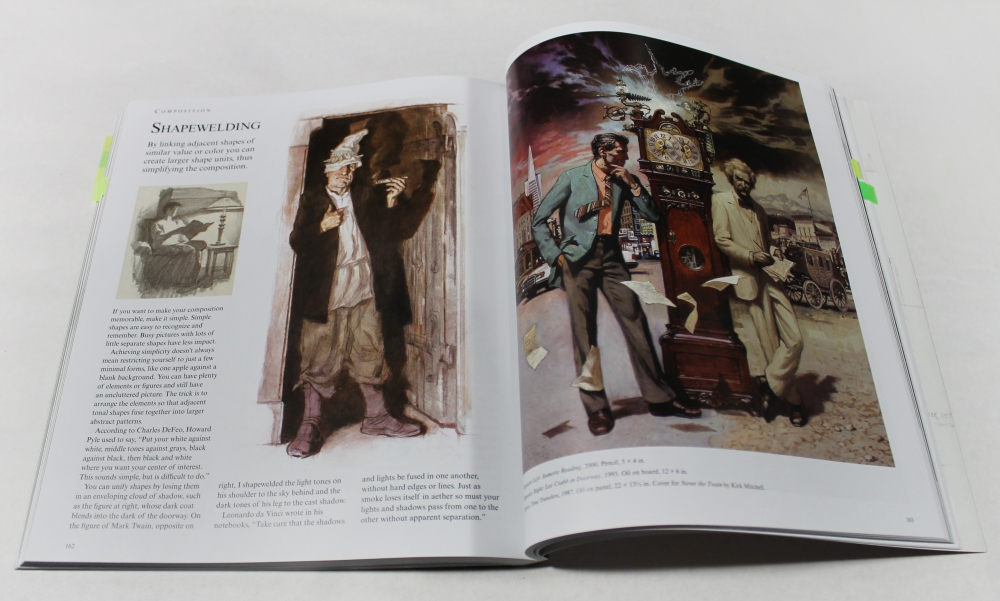
Next is a technique he calls shapewelding. And it's one of the sections of the book that really made something click in my head. The idea of shapewelding I think is similar to that of lost edges, but with value instead. It's always tempting to want to differentiate the edges of objects when their values are similar, but this illustrates how well doing the exact opposite works, especially for simplifying compositions, something that I've always had a bit of trouble with.
Eye Tracking
Something I really liked about the whole composition section in general was that it didn't just go over the usual rules you hear about composition. In this section specifically it dispels a lot of myths about how the eye moves through an image. The reality is that no two people view an image in the same way and the places we look are primarily determined by the story being told in the image. Which I think makes a lot more sense.
Anyways I hope you found this review helpful. If you have any questions leave a comment, otherwise please consider subscribing/following me. I don't have many books at hand to review but I've been thinking of reviewing some of the books that you can find in the public domain as I work my way through them.
If you want me to do more in-depth reviews like this on newer books please consider supporting me on patreon.
How I Research / Work Through Books
I might expand this into another post when I have actually worked through most of the book.
How I Research for Fiction Books
So doing research for the book I mentioned I'm writing I bought a lot of old used physical books. I did't mind highlighting them but it was a complete mess because I make so many highlights. I didn't want to have to scan them all to make myself a more usable PDF (even the notes themselves are hard to then extract, only method I've found is the Goodreader app on the iPad).
In the end I found this app called eHighlighter. Basically you take a photo, it OCRs it (Optical Character Recognition, basically it converts images to text), and it's easy to organize the highlights by book. There are free apps that can OCR photos but none really aimed at books like this ones. It works decently enough. It's a bit finicky with years, quotes, weird symbols, and curved photos/lines, but it wasn't as bad as any of the other options (like scanning the book, or transcribing the highlights myself).
I then take all these notes, dump them into Scrivener and further mark/highlight them to differentiate different types of notes. It's basically a condensed version of the book, a reverse engineering of the author's outline, and makes it a lot easier to see connections and get the big picture.
How I Work Through Art Books
Obviously art books don't require such complex orderly notes.
You can usually get a sense for how good an art book is from just the pictures. When I was younger and would go to the library/bookstore I would just look at the pictures more than the text. I wasn't as serious about art and I didn't even think of working through a book like I do now. At least I made some notes about which books looked good, but I wish I'd made more detailed notes because it's hard finding many of the books I used to read and they're all in spanish when I do.
But I've never really worked myself through an art book so densely packed with information. Even with my anatomy book, which I've worked through many parts of now, it's only really about the diagrams. Working through it is not so much about reading it but copying and understand those diagrams, so I haven't had to highlight a lot of text. I can just leave a few of those colored sticky arrows.
Some books already have an order to them. This is very typical of say perspective books for example. In those cases you can usually try to tackle on section at a time and literally work your way through the book. The highlights are usually few because you have to apply the information in a certain section until you learn it and by then it's mostly stuck in your head. I would suggest though marking areas that gave you a lot of trouble or which you'll be referencing often just so that they're easy to find.
How I Break Down Complex Art Books
But then there are more complex books like this one. At first I tried to use the sticky arrows to show many notes I was taking, but I ran out of arrows! I didn't really need the notes to be searchable though so I just took some quick photos.
Additionally I made a list as you saw of all the artists (because of the review) and starred the ones I hadn't heard of so I could investigate those.
I also made myself a list of things I'm going to try and since they're all different sorts of things and the book has no real order, I've re-ordered them for myself, dividing them into supplies/tools, styles, and methods, reference (techniques/modeling methods), and general advice. Then ordered each section from easiest to hardest to just stuff I don't have the materials for.
The goal much like before was to condense the book into something that's a lot more manageable and a lot less intimidating.
I've done this before to some extent with public domain books because you can get them in a PDF, but never quite like this. If you're working through a PDF you can color code your highlights to signify the sections I mentioned, but I think it's still better to have an actual list as well if you can take the time to write it down or figure out how to extract those highlights.
List of Artists Mentioned in the Book
I sorted the list by first name.
Albert Bierstadt
Anders Zorn
Arnold Böcklin
Arthur Rackham
Coles Phillips
Dean Cornwell
Diego Velázquez
Dominique Vivant Denon
Edward Hopper
Edwin Austin Abbey
Federico Barocci
Frank Brangwyn
Frederic Edwin Church
Giovanni Battista Tiepolo
Haddon Sundblom
Hal Foster
Harvey Dunn
Howard Pyle
J.L. Leyendecker
Jean-Léon Gérôme
Jehan Georges Vibert
Jessie Willcox Smith
John Singer Sargent
Leonardo da Vinci
M. C. Escher
Maxfield Parrish
Milton Caniff
N. C. Wyeth
Norman Rockwell
Roy Crane
Thomas Cole
Thomas Moran
Théodore Géricault
William Turner
William-Adolphe Bouguereau